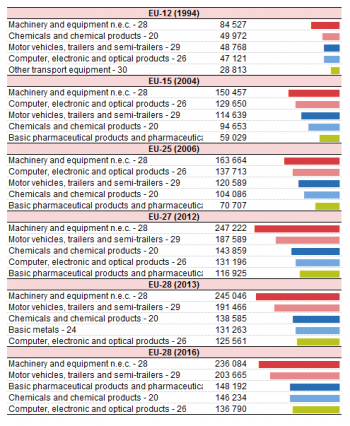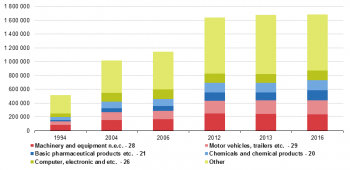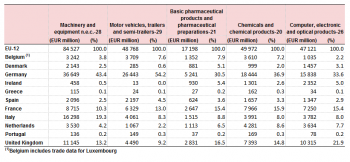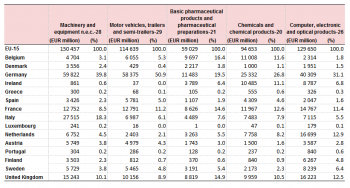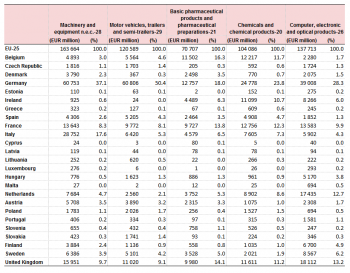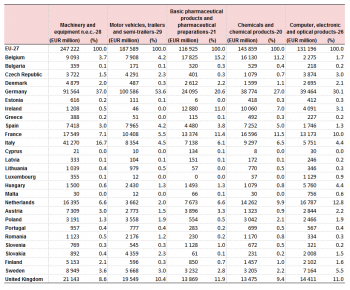Archive:Main goods in extra-EU exports
- Data extracted in September 2017. Most recent data: Further Eurostat information, Main tables and Database. Planned article update: September 2018
This article focuses on the most significant goods by value (according to the CPA classification) in extra-EU exports. It presents statistics for the EU-28 (2013 and 2016), EU-27 (2012), EU-25 (2006), EU-15 (2004) and EU-12 (1994) aggregates. Statistics on goods traded between the EU and the world — especially the size and evolution of exports — enable the EU and national authorities to evaluate the health and competitiveness of EU industries. These statistics also provide EU businesses with essential information for their sales and marketing policies.
Main statistical findings
Extra-EU exports tripled between 1994 and 2016, in part due to successive increases in the composition of the EU.
In this period the most exported goods were:
- machinery and equipment (CPA 28),
- motor vehicles (CPA 29),
- pharmaceutical products (CPA 21) ,
- chemical products (CPA 20) and
- computer, electronic and optical products (CPA 26).
Evolution of extra-EU export
The value of extra-EU exports has grown from EUR 542 billion in 1994 to EUR 1 744 billion in 2016 (see Figure 1). It must be noted that this rise reflects to a large extent the increase in the composition of the EU over this period.
In the same period the value of extra-EU imports grew slighty less from EUR 539 billion in 1994 to EUR 1 710 billion in 2016 (see Extra-EU imports of the most traded goods). Consequently the trade balance grew from EUR 3 billion in 1994 to EUR 33 billion in 2016. However in between these two years the trade balance had been as low as EUR - 185 billion in 2006 (see Extra-EU trade in goods).
The evolution of the value of the top 5 products exported within the EU follows a similar trend. In 1994, the value of these products was EUR 259 billion which was 48 % of the value of all extra-EU exports. In 2004 (EUR 548 billion) and 2006 (EUR 597 billion), this share was slightly more than 50 % but in 2012 and 2013, it dropped back to 49 % and 48 % respectively. Finaly in 2016 at (EUR 871 billion) it was almost exactly 50 %.).
The 5 most significant products in extra-EU exports
There has been a degree of consistency in the top 5 products in extra-EU exports in terms of value. Four of them appear during the whole period. These are ‘Machinery and equipment’, ‘Motor vehicles, trailers and semi-trailers’ , ‘Chemicals and chemical products’ and ‘Computer, electronic and optical products’. ‘Basic pharmaceutical products’ appear in four of the six years shown and was replaced by ‘Other transport equipment‘ in 1994 and by ‘Basic metals‘ in 2013 but reappeared in 2016. (see Table 1)
‘Machinery and equipment’ held the first place in all years show. ‘Motor vehicles, trailers and semi-trailers’ started out as third but reached 2nd in 2012 where it stayed. ‘Computer, electronic and optical products’ started as 4th in 1994, rose to 2nd in 2004 and 2006 but then fell back to 4th in 2012 and 5th in 2013 and 2016. ‘Chemicals and chemical products’ was 2nd in 1994, dropped to 4th in 2004 and 2006 climbed to 3rd in 2012 and 2013 but had to settle for 4th in 2016. ‘Basic pharmaceutical products’ which had been 5th in 2004, 2006 and 2012,dropped out of the top 5 in 2013 but reappeared as 3rd in 2016.
Figure 2 shows the top 5 products of 2016 over the whole period. Between 1994 and 2004 the largest growth is found in ‘Computer, electronic and optical products’. After 2004 export values of ‘Computer, electronic and optical products’ since 2004 do not grow much and are overtaken by ‘Motor vehicles, trailers and semi-trailers’ and ‘Chemicals and chemical products’ in 2012 and by ‘Basic pharmaceutical products’ in 2016.
Figure 3 adds 'Other' to the top 5 products thus showing the total value of exports. Three of the five products as well at 'Other' grow by 4.8 to 5.1 %. Motor vehicles grow slightly more by 6.7 %. It is in 'Basic pharmaceutical products' we find the highest growth of more than 10.3 % lifting the total growth to 5.5 %.
Most traded goods in Extra-EU exports by Member State
The analysis in this section looks at extra-EU exports by individual EU Member State. Table 2 shows that in 1994, Germany was the leading EU exporter with the highest total volume trade in each of the 5 most significant products (‘Machinery and equipment’ (EUR 37 billion), ‘Motor vehicles, trailers and semi-trailers’ (EUR 26 billion), ‘Basic pharmaceutical products’ (EUR 5 billion), ‘Chemicals and chemical products’ (EUR 18 billion) and ‘Computer, electronic and optical products’ (EUR 16 billion). The 2nd to 4th position in each of these products are almost always held by Italy, the United Kingdom and France albeit in differing order. Only in ‘Chemicals and chemical products’ Italy is missing and the Netherlands is 4th.
In 2004 Austria, Finland and Sweden join the EU. For all of the five most exported goods their shares are lower than 7 % and consequently they do not appear among the top four exporters for these goods. Germany remains in the first spot for all five. Belgium replaces Italy in ‘Basic pharmaceutical products’. Belgium and Ireland replace the Netherlands and the United Kingdom in ‘Chemicals and chemical products’ while the Netherlands Italy in ‘Computer, electronic and optical products’.
In 2006, ten countries (Czech Republic, Estonia, Cyprus, Latvia, Lithuania, Hungary, Malta, Poland, Slovenia and Slovakia) join the EU. Their combined exports in the five product categories range from 3.4 % in ‘Chemicals and chemical products’ to 6.9 % in ‘Computer, electronic and optical products’. Germany remains in the first spot for all five products. With the exception of Ireland losing its fourth place to the United Kingdom there are no changes in the countries appearing as top four exporters for the product shown.
In 2012, Bulgaria and Romania entered the EU. Except for Romania's share of 1.2 % in exports of ‘Motor vehicles, trailers and semi-trailers’ their contributions for the five most exported products were below 1%. German Extra-EU export shares remained first and grew for four of the five products, while remaining almost stable in ‘Machinery and equipment‘. The Netherlands replaced the United Kingdom as the fourth largest exporter of ‘Chemicals and chemical products'.
Although there was only one new member state, Croatia, and one year between 2012 and 2013, France lost its place in the top four in both 'Machinery and equipment' and 'Motor vehicles, trailers and semi-trailers' to the Netherlands and Spain respectively. Once again Germany remained the largest Extra-EU exporter for all five products.
Between 2013 and 2016 the composition of the EU remained unchanged. In this period total EU exports dropped for ‘Machinery and equipment‘ but grew for the other four products, most notably in ’Basic pharmaceuticals’ from EUR 118 billion in 2013 to EUR 148 billion in 2014. Germany, growing with EUR 10 billion and Ireland growing with EUR 8 billion contributed most to this growth. France's growth of EUR 1 billion meant they were overtaken by Ireland which jumped from 5th to 2nd place.
Data sources and availability
EU data comes from Eurostat’s COMEXT database.
COMEXT is the Eurostat reference database for international trade in goods. It provides access not only to both recent and historical data from the EU Member States but also to statistics of a significant number of non-EU countries. International trade aggregated and detailed statistics disseminated from Eurostat website are compiled from COMEXT data according to a monthly process. Because COMEXT is updated on a daily basis, data published on the website may differ from data stored in COMEXT in case of recent revisions.
European statistics on international trade in goods are compiled according to the EU concepts and definitions and may, therefore, differ from national data published by Member States.
Product classification
Classification of products by activity (CPA) is a statistical classification of products and services obligatory for all EU Member States. CPA classifies products by activity in which they are produced. Products are transportable goods and services. The CPA is a product classification whose elements are related to activities as defined by NACE Rev. 2. Each product - whether it be a transportable or a non-transportable good or a service - is assigned to one single NACE Rev. 2 activity. The linkage to activities as defined by NACE Rev. 2 gives the CPA a structure parallel to that of NACE Rev. 2 at all levels distinguished by NACE Rev. 2.
Unit of measure
Trade values are expressed in millions (106) of euros. They correspond to the statistical value, i.e. to the amount which would be invoiced in case of sale or purchase at the national border of the reporting country. It is called a FOB value (free on board) for exports and a CIF value (cost, insurance, freight) for imports.
Context
See also
- International trade in goods
- Extra-EU exports of the most traded goods
- Intra-EU trade of the most traded goods
Further Eurostat information
Data visualisation
- Did you know? Some funny and curious facts about trade of the EU
- Top 5 partners in trade in goods
- My Country in a bubble
Main tables
- International trade in goods - long-term indicators (t_ext_go_lti)
- International trade of machinery and transport equipment (SITC 7), by declaring country (tet00009)
- Extra-EU28 trade of machinery and transport equipment (SITC 7), by Member State (tet00059)
- Extra-EU28 trade of machinery and transport equipment (SITC 7), by main partners (tet00030)
- International trade in goods - short-term indicators (t_ext_go_sti)
- Imports of goods - machinery and transport equipment (teiet170)
- Exports of goods - machinery and transport equipment (teiet070)
Database
- International trade in goods - aggregated data (ext_go_agg)
- International trade in goods - detailed data (detail)
Dedicated section
Methodology / Metadata
- International trade in goods statistics - background
- International trade in goods (ESMS metadata file — ext_go_esms)
- User guide on European statistics on international trade in goods
Source data for tables, figures and maps (MS Excel)
Other information — Legal background
- Regulation (EC) No 471/2009 of 6 May 2009 on Community statistics relating to external trade with non-member countries
- Regulation (EU) No 92/2010 of 2 February 2010 implementing Regulation (EC) No 471/2009, as regards data exchange between customs authorities and national statistical authorities, compilation of statistics and quality assessment
- Regulation (EU) No 113/2010 of 9 February 2010 implementing Regulation (EC) No 471/2009 , as regards trade coverage, definition of the data, compilation of statistics on trade by business characteristics and by invoicing currency, and specific goods or movements.
External links
Notes
[[Category:<Subtheme category name(s)>|Name of the statistical article]] [[Category:<Statistical article>|Name of the statistical article]]
Delete [[Category:Model|]] below (and this line as well) before saving!

